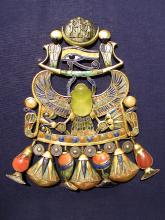Listen to today's episode of StarDate on the web the same day it airs in high-quality streaming audio without any extra ads or announcements. Choose a $8 one-month pass, or listen every day for a year for just $30.
You are here
Moon and Spica
Bright stars have served as more than markers in the sky. They’ve helped many cultures align their temples and other major buildings, and establish their calendars. And one of the most important stellar markers is Spica, the leading light of Virgo.
Research a few years ago said that Spica may have played a role in establishing the first major calendar in Armenia, for example. The calendar began around the year 9,000 BC, when Spica first appeared in the dawn sky, shortly before the summer solstice.
Other research says the star might have been used in the alignment of some monasteries in India. And Spica definitely was used to align temples in ancient Greece.
Perhaps the star’s best-known alignment was with a temple in ancient Egypt. It was built 5200 years ago, dedicated to an early goddess. It lined up with the point on the eastern horizon where Spica rose.
The temple gained greater fame a few thousand years later. A Greek astronomer noticed that the temple no longer aligned with Spica’s rising point. Comparisons with other records confirmed that Spica and all the other stars shift position over time. The shift is caused by precession — a slight “wobble” in Earth’s rotation on its axis. It takes a long time to notice that shift — a change in the alignment of the stars.
And Spica aligns with the Moon tonight. It’s to the lower left of the Moon at nightfall, and closer to the Moon as they set around 1 or 2 in the morning.
Script by Damond Benningfield




